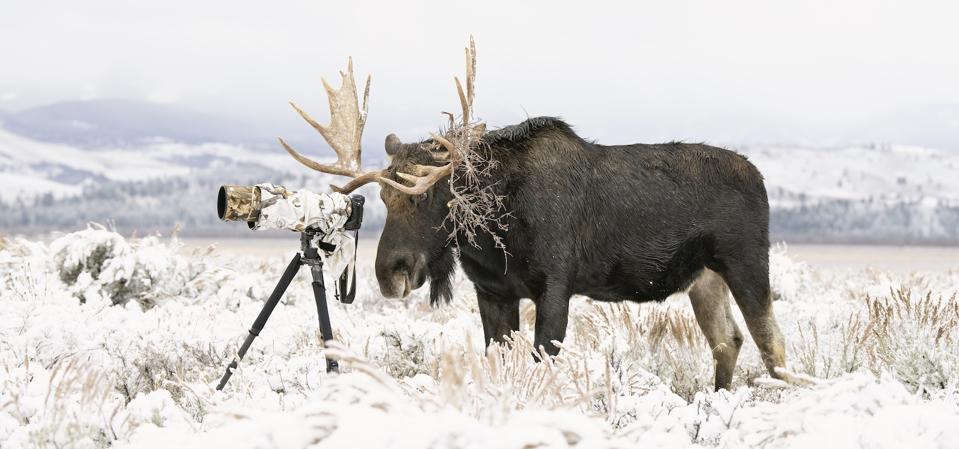
These four images capture various starkly different realities within the animal kingdom — from family and play to survival and migration.
By © Deena R. Sveinsson of Estes Park, Colorado, USA
Each year, Nature’s Best Photography highlights moments in the animal kingdom that last only seconds, yet are highly revealing of the very essence of life in the wild. In these four images, photographers have managed to capture the various different ways that animals interact with each other and their environment.
From tender family bonds to playful social dynamics, these images tell stories beyond what the naked eye can usually observe. Here are four winning photos that invite you to look closer at the natural world.
1. Emperor Penguins (Antarctica)
Emperor penguins
By © Thomas Vijayan, Ontario, Canada
Thomas Vijayan’s image captures an emperor penguin (Aptenodytes forsteri) family huddled against the Antarctic cold. Here, survival is a group effort: both parents share the duty of incubating their eggs, while simultaneously caring for the chicks nestled safely between them.
“A penguin chick nestled within the warm embrace of its devoted parents finds solace amidst the icy expanse,” explains photographer Vijayan. “This tender display of familial unity speaks volumes about the resilience and fortitude of life in one of the harshest environments on Earth.”
What makes this photo remarkable isn’t just the frigid beauty of Antarctica. Rather, it’s the story it tells about resilience and cooperation. This is just one of many precious moments that define life in one of Earth’s harshest habitats. Vijayan’s patience, lying flat on the ice for hours, is what earned him the grand prize in the 2025 Nature’s Best Photography Awards.
2. The Flight Of The Great Hornbill (Yunnan, China)
Great hornbill in flight
By © Lisiqi Ye, at age 17, of Beijing, China
The great hornbill (Buceros bicornis) in flight is a study in precision, ritual and patience. Photographer Lisiqi Ye spent days observing a male hornbill courting his mate. He made note of every careful landing, fig delivery and test flight.
On the day he captured this highly honored shot, the bird seemed to hang in the air, suspended between intention and instinct. “I spent days in a hide facing a fig-rich cavity of a tree claimed by a pair of great hornbills,” Ye explained. “On the day I took this picture, the male came home heavy with fruit. He faced the wind and bled off speed; wingbeats drummed; the casque caught the sun.”
Beyond its dramatic composition, this image tells a story about the rhythms of life in Hornbill Valley. Here, survival, reproduction and social behavior are all tightly interwoven. Ye’s patience, observation and understanding of the hornbill’s natural choreography is what earned him the win in the Youth Photographer of the Year category.
3. Playful Mountain Gorillas (Bwindi Impenetrable National Park, Uganda)
Mountain gorillas
By © David Swindler of Kanab, Utah, USA
In Bwindi’s dense forests, mountain gorillas (Gorilla beringei beringei) play with an intensity that both teaches and entertains the youth in equal measure. Photographer David Swindler captured a small sibling persistently pestering a larger one; it’s a scene that, to us, looks comical, but is actually essential for social learning in the gorilla world.
“These playful youngsters were comical to observe when we trekked through this critical gorilla forest habitat,” Swindler explained. The image gives us a window into the social bonds and behavioral development of these endangered primates. Play, to them, is a vital part of survival, skill-building and group cohesion. His capturing this wholesome truth is what made Swindler deserving of the win in the Animal Antics category.
4. Grizzly Bear Crossing (Lake Clark National Park, Alaska)
Grizzly bear crossing
By © Henry H. Holdsworth of Jackson, Wyoming, USA
Holdsworth’s photograph of grizzly bear (Ursus arctos horribilis) tracks in Alaska’s tidal mudflats is a masterclass in observation. The criss-crossing tracks, highlighted favorably by the natural lighting, capture both the movement of these powerful mammals and the ever-changing environment in which they live.
“I positioned my camera as high as possible to capture this image of bear paw prints criss-crossing through the cracked and oozing mud,” Holdsworth explained. “I liked the way the lighting made the tracks look raised up in places and slightly three-dimensional.” The image emphasizes how the grizzly’s daily navigation and environmental interaction create patterns that are both beautiful and scientifically informative.
These four images may be distinct in terms of species and setting, but they still share a common thread: they invite us to look closer, to see the complexity and wonder of life in the wild. Through patience, observation and technical skill, these photographs offer us invaluable lessons about the behavior adaptation and fun that unfolds beyond human eyes.
Are you an animal lover who owns a pet? Take the science-backed Pet Personality Test to know how well you know your little friend.
